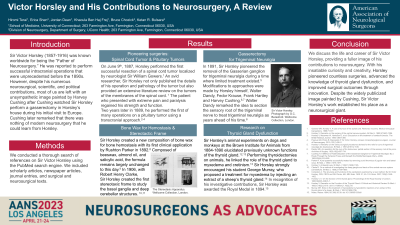Victor Horsley and His Contributions to Neurosurgery, A Review
Victor Horsley and His Contributions to Neurosurgery, a Review
Friday, April 21, 2023


Hiromi Terai (she/her/hers)
Medical Student
UConn School of Medicine
Farmington, Connecticut, United States
ePoster Presenter(s)
Introduction: Sir Victor Horsley (1857-1916) was known worldwide for being the “Father of Neurosurgery.” He was reported to perform successful intracranial operations that were unprecedented before the 1890s. However, despite his numerous neurosurgical, scientific, and political contributions, most of us are left with an unsympathetic image painted by Harvey Cushing after Cushing watched Sir Horsley perform a gasserectomy in Horsley’s house during his initial visits to Europe.
Methods: We conducted a thorough search of references on Sir Horsley using the PubMed search engine. We included scholarly articles, newspaper articles, journal entries, and surgical and neurosurgical texts.
Results: In this presentation, we discuss Sir Horsley’s inquisitive mind, his impactable anatomic knowledge, his decisive surgical skills, and his various research contributions. We describe the famous cases that were performed by Sir Horsley, such as the first removal of a spinal tumor and the first transcranial pituitary surgeries, as well as Sir Horsley’s development of gasserectomy for trigeminal neuralgia. We also explore the various other contributions that he made to the neurosurgery field, such as the development of bone wax for hemostasis, the invention of the stereotactic frame to study basal ganglia and deep structures of the cerebellum, and Sir Horsley’s research on thyroid gland dysfunction.
Conclusion : Our presentation discusses the life and career of Sir Victor Horsley in detail, providing a fuller image of his contributions to neurosurgery.
Methods: We conducted a thorough search of references on Sir Horsley using the PubMed search engine. We included scholarly articles, newspaper articles, journal entries, and surgical and neurosurgical texts.
Results: In this presentation, we discuss Sir Horsley’s inquisitive mind, his impactable anatomic knowledge, his decisive surgical skills, and his various research contributions. We describe the famous cases that were performed by Sir Horsley, such as the first removal of a spinal tumor and the first transcranial pituitary surgeries, as well as Sir Horsley’s development of gasserectomy for trigeminal neuralgia. We also explore the various other contributions that he made to the neurosurgery field, such as the development of bone wax for hemostasis, the invention of the stereotactic frame to study basal ganglia and deep structures of the cerebellum, and Sir Horsley’s research on thyroid gland dysfunction.
Conclusion : Our presentation discusses the life and career of Sir Victor Horsley in detail, providing a fuller image of his contributions to neurosurgery.
